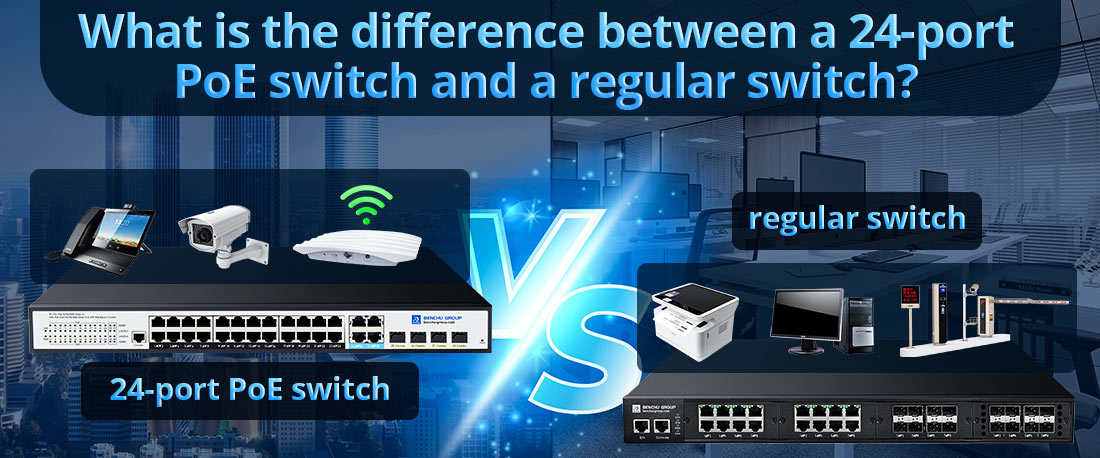
La principale différence entre un commutateur PoE à 24 ports et un commutateur classique (non PoE) réside dans leur capacité à fournir de l'énergie électrique aux appareils connectés via des câbles Ethernet. Voici une description détaillée des différences :
1. Capacité d'alimentation par Ethernet (PoE)
Commutateur PoE 24 ports :
Fournit à la fois l'alimentation et les données via un seul câble Ethernet aux appareils compatibles PoE (par exemple, caméras IP, téléphones VoIP, points d'accès sans fil).
Conforme aux normes PoE telles que :
--- IEEE 802.3af (PoE) : Fournit jusqu’à 15,4 W par port.
--- IEEE 802.3at (PoE+) : Fournit jusqu’à 25,5 W par port.
--- IEEE 802.3bt (PoE++): Fournit jusqu'à 60 W (Type 3) ou 100 W (Type 4) par port.
Élimine le besoin d'adaptateurs d'alimentation ou de prises électriques séparés pour les appareils.
Changement régulier :
--- Transmet uniquement les données via des câbles Ethernet.
--- Ne fournit pas d'énergie, ce qui nécessite que les appareils connectés disposent de leurs propres sources d'alimentation.
2. Cas d'utilisation
Commutateur PoE 24 ports :
Idéal pour les configurations où les appareils nécessitent à la fois de l'alimentation et des données, telles que :
--- Systèmes de surveillance IP (caméras IP).
--- Systèmes de communication VoIP.
--- Réseaux sans fil (points d'accès Wi-Fi).
--- Appareils IoT (capteurs intelligents, éclairage).
Changement régulier :
Convient aux réseaux où les appareils disposent d'alimentations indépendantes, tels que :
--- Ordinateurs de bureau.
--- Imprimantes.
--- Périphériques de stockage réseau (NAS).
3. Flexibilité d'installation
Commutateur PoE 24 ports :
--- Permet le déploiement d'appareils dans des endroits sans prises électriques à proximité, tels que les plafonds, les espaces extérieurs ou les emplacements éloignés.
--- Réduit l'encombrement des câbles en combinant l'alimentation et la transmission de données en un seul câble.
Changement régulier :
--- Nécessite d'installer les appareils à proximité de prises de courant ou d'utiliser des rallonges, ce qui limite la flexibilité de placement.
4. Bilan de puissance
Commutateur PoE 24 ports :
--- Possède un budget de puissance spécifié, qui correspond à la puissance totale maximale qu'il peut fournir sur tous les ports compatibles PoE.
--- Exemple: A Commutateur PoE 24 ports avec un budget de puissance de 370 W, il peut fournir jusqu'à 25,5 W sur plusieurs ports simultanément, dans le cadre du budget total.
--- Les ports peuvent allouer automatiquement l'alimentation en fonction des exigences de l'appareil.
Changement régulier :
--- N'a pas de budget d'alimentation puisqu'il ne fournit pas d'énergie aux appareils.
5. Coût
Commutateur PoE 24 ports :
--- Généralement plus cher que les commutateurs classiques en raison du matériel d'alimentation électrique supplémentaire et de la fonctionnalité PoE.
Changement régulier :
--- Plus rentable pour les réseaux sans exigences de périphérique PoE.
6. Consommation d'énergie
Commutateur PoE 24 ports :
--- Consomme plus d'énergie car il alimente les appareils connectés en plus de gérer le trafic de données.
--- La consommation d'énergie au repos est plus élevée en raison du matériel PoE.
Changement régulier :
--- Consomme moins d'énergie car il gère uniquement la transmission des données.
7. Fonctionnalités de sécurité
Les deux types de commutateurs incluent souvent des fonctionnalités de sécurité similaires telles que :
--- Prise en charge du VLAN pour isoler le trafic réseau.
--- Authentification du port (802.1X) pour empêcher les connexions d'appareils non autorisées.
--- Listes de contrôle d'accès (ACL) pour une sécurité réseau améliorée.
--- Cependant, les commutateurs PoE peuvent inclure des outils de surveillance avancés pour gérer la consommation électrique par port.
8. Bande passante et performances
Commutateur PoE 24 ports :
--- Les performances sont comparables à celles d'un commutateur classique, offrant une bande passante similaire (par exemple Gigabit Ethernet ou 10 Gigabit Ethernet) pour la transmission de données.
--- La fonctionnalité PoE supplémentaire n'affecte pas les vitesses de transmission des données.
Changement régulier :
--- Se concentre uniquement sur la transmission de données sans considérations supplémentaires en matière de gestion de l'énergie.
9. Entretien et dépannage
Commutateur PoE 24 ports :
--- Les commutateurs PoE gérés incluent souvent des outils permettant de surveiller la consommation d'énergie par port, de redémarrer les appareils à distance et de dépanner les appareils PoE connectés.
Changement régulier :
--- Limité aux diagnostics et au dépannage liés aux données.
10. Évolutivité future
Commutateur PoE 24 ports :
--- À l'épreuve du temps pour les réseaux prévoyant d'intégrer davantage de dispositifs PoE tels que des caméras IP, des points d'accès ou des systèmes IoT.
--- Réduit le besoin d'alimentations supplémentaires lors de la mise à l'échelle.
Changement régulier :
--- Peut nécessiter des équipements supplémentaires, tels que des injecteurs PoE ou des dispositifs Midspan, pour prendre en charge les appareils compatibles PoE à l'avenir.
Conclusion
Un 24 ports Commutateur PoE est une solution polyvalente conçue pour les réseaux comportant des appareils nécessitant à la fois de l'alimentation et des données via des câbles Ethernet, tels que des caméras IP, des téléphones VoIP et des points d'accès Wi-Fi. Il simplifie les installations, améliore la flexibilité et prend en charge la gestion centralisée de l'énergie.
D'un autre côté, un commutateur classique constitue un choix rentable pour les réseaux dans lesquels les appareils disposent de sources d'alimentation indépendantes et n'ont besoin que de connexions de données. Lors de la planification d'un réseau, la décision entre les deux dépend de la nécessité ou non de la fonctionnalité PoE pour les besoins actuels ou futurs des appareils.